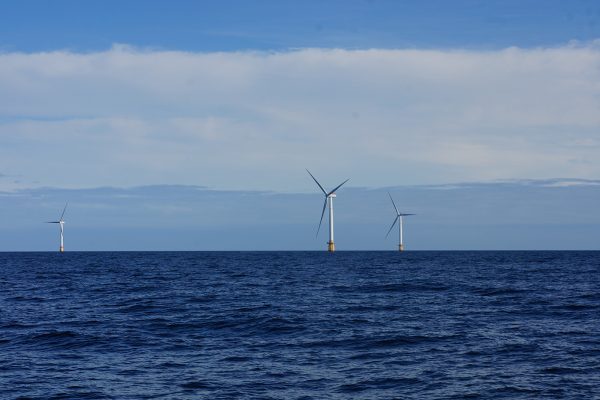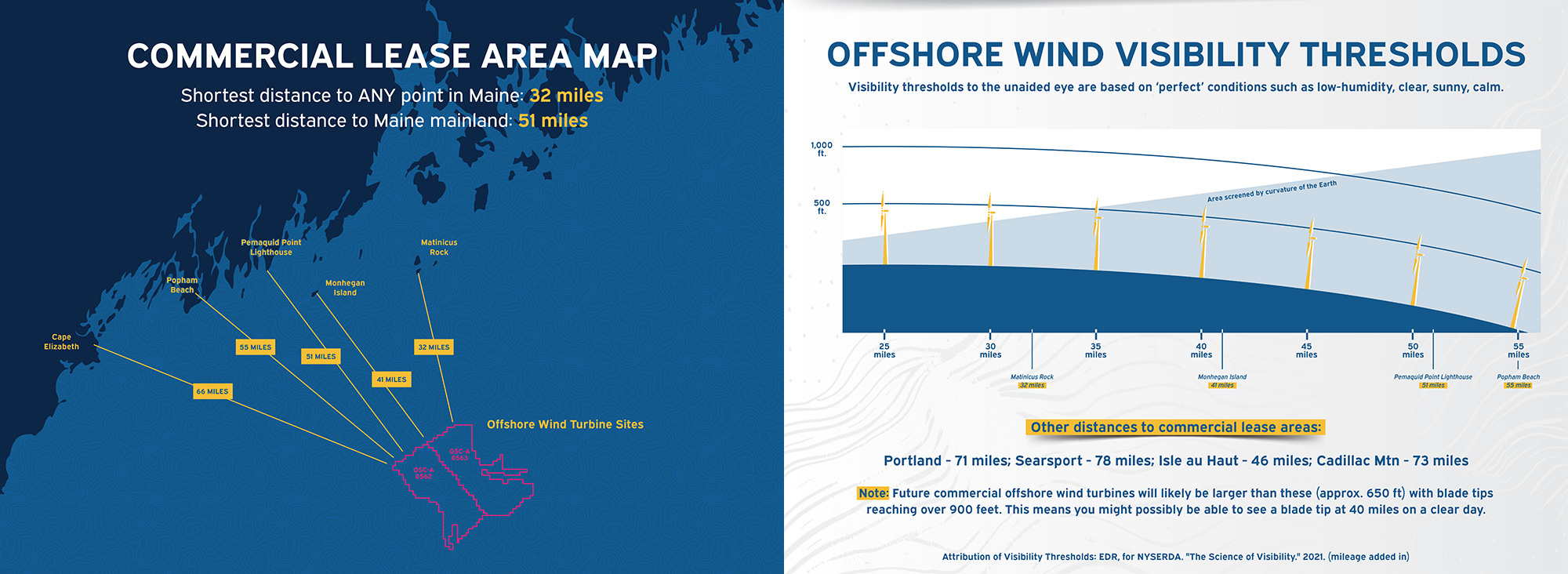Rather than addressing the root causes of high energy costs for Mainers (hint: it’s our over-reliance on fossil fuels), some opponents of clean energy have chosen to spread misinformation. This has led to widespread confusion without offering solutions to the energy affordability issues facing Maine families every day.
One favorite target for these false claims is offshore wind. The Gulf of Maine has some of the strongest and most consistent winds in the world, making it the most abundant and promising clean energy resource available to us.
In this blog, we won’t restate all the false claims being made by opponents of clean energy, but we will set the record straight on what you should know about offshore wind in Maine.

Photo by JShapiro/NRCM
Offshore Wind Reduces Energy Prices Across New England
Offshore wind is expected to put downward pressure on wholesale market prices in New England, which will be passed through to Maine electricity customers. One way it does this is by replacing expensive oil-fueled power plants that are fired up during periods of high demand. A study released in September 2025 showed that offshore wind power would generate massive savings during high-demand periods, lowering New England electricity prices by 11% and delivering $400 million in wholesale market savings in just three winter months.
In fact, stalling progress on offshore wind will actually lead to higher electricity prices. For example, the State of Connecticut estimated that the Trump Administration’s plan to cancel Revolution Wind, which is already 80% completed, could cost electricity customers across New England, including Maine, $500 million per year in higher supply costs.
Offshore Wind Will Bring Enormous Economic Benefits to Maine
Responsibly developed offshore wind would be a big boost to Maine’s economy and local communities and aligns with Maine’s more than 400-year maritime and shipbuilding heritage.
An independent study released in 2025 showed that an offshore wind port in Maine would support more than 6,000 jobs during construction, an average of nearly 1,000 jobs annually through 2050, and deliver total economic benefits of $6.6 billion.
That’s why support for a new offshore wind industry spans from the Maine State Chamber of Commerce to Maine’s labor unions.
Offshore Wind Projects Can Be Sited to Avoid Conflict with Maine’s Fishing Industry
Everyone involved in advocating for offshore wind in the Gulf of Maine has made clear that understanding potential impacts to Maine’s fishing industry is essential, so any emerging impacts can be first avoided, then minimized or mitigated.
The best way to avoid impacts is by making sure turbines aren’t located in prime fishing grounds. That’s why NRCM and our partners worked to pass Maine’s 2023 offshore wind bill, which required that projects not be placed in federal Lobster Management Area 1 (LMA1), where nearly all of the Maine-based lobster fleet fish.
The provisions in the bill, plus bipartisan support from Maine’s Congressional delegation and the Mills Administration led to the federal government excluding LMA1 from commercial offshore wind leasing, a big step toward allowing both clean energy and a vibrant fishing industry to exist in the Gulf of Maine at the same time.
Offshore Wind Will Not Be Visible from the Mainland
Commercial offshore wind lease areas in the Gulf of Maine are more than 50 miles from the mainland at their nearest point, will not be visible from shore, and will have no impact on property values.

Offshore Wind Turbines Don’t Harm Whales
There is no scientific evidence linking offshore wind and whale deaths. In fact, the greatest risks whales face are vessel strikes, shifting food species due to climate change, and entanglement with fishing gear.
There is, however, clear evidence linking anti-offshore wind groups that frequently claim a connection between whale deaths and offshore wind to fossil fuel-funded think tanks.
The 2024 Federal Lease Sale was a Vote of Confidence in the Long-term Promise of Offshore Wind in the Gulf of Maine
In October 2024, four commercial floating offshore wind leases were sold in the Gulf of Maine. This exceeded expectations and served as a vote of confidence from developers in the long-term viability and promise of offshore wind in the Gulf of Maine, despite political uncertainty, as the lease sale took place days before the 2024 Presidential elections. The four leases make clear that industry is interested in investing in offshore wind if given the chance.
Fossil Fuel Power Generation Has Far Higher Emissions than Offshore Wind, Even Including Materials and Construction
Studies have shown that clean energy like solar and wind have substantially lower lifetime greenhouse gas emissions than other fossil fuels. Including materials, construction, fuel, and decommissioning, wind power (including offshore wind) emits 37 times less greenhouse gases per unit of power generated than natural gas, and 77 times less than coal.
All sources of energy have an impact. The question should be what sources have the lowest. The damaging impacts of our existing fossil fuel system on our health and climate are colossal compared to other clean energy sources that have much lower impacts.
Offshore Wind Can Be Responsibly Developed to Protect Wildlife
Climate change is the greatest threat facing the more than 3,000 marine species and birds in the Gulf of Maine. Replacing polluting fossil fuels with cleaner energy sources like wind is our best opportunity to protect wildlife.
Using the best data and scientific research available, offshore wind projects in the Gulf of Maine will be held to the highest standards for siting and operations to protect ocean wildlife and ecosystems. Developers will be required to include strong protections for wildlife and the ocean environment for both construction and operations.
It’s crucial that Mainers seek out information from trusted sources. Disinformation is easily spread via social media and should be treated skeptically. NRCM and our partner organizations will continue to educate our supporters and the public using the best information available from scientists and other experts.
We can’t keep relying on expensive fossil fuels to power our homes and businesses. Not only does it drive up electricity prices, it fuels climate change, which is making the storms and flooding harming our communities worse. Responsibly developing offshore wind will generate the large amounts of reliable domestic energy we need to power the future and help keep energy costs affordable.
—Jack Shapiro, NRCM Climate & Clean Energy Director











Leave a Reply